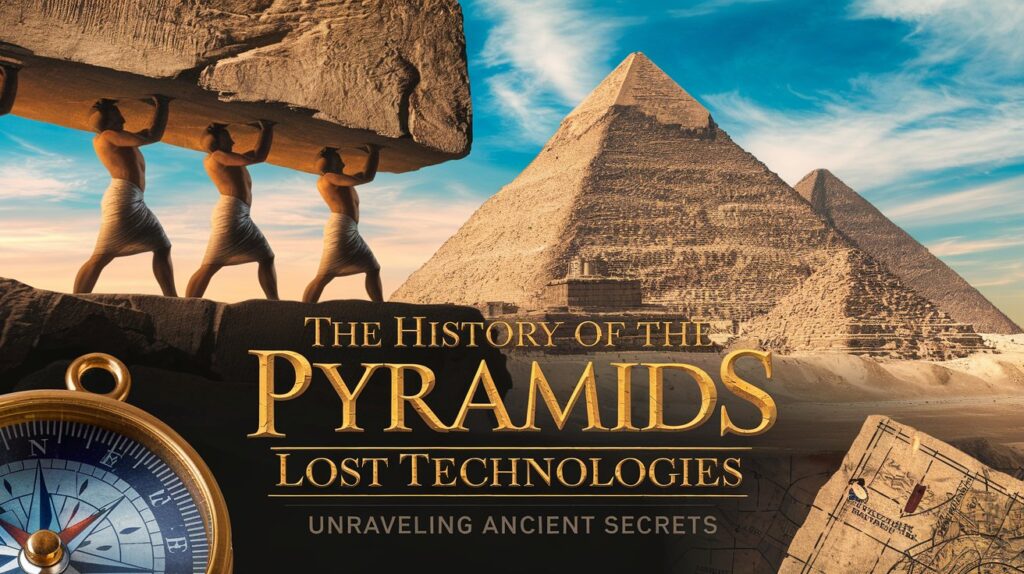The History of the Pyramids: Lost Technologies

Introduction
The pyramids of Egypt stand as monumental testaments to the architectural prowess and cultural sophistication of ancient civilizations. While the Great Pyramid of Giza is one of the most recognized structures in the world, its construction has long been a subject of intrigue, sparking theories about lost technologies and ancient engineering techniques. This article explores the history of the pyramids, the methods used in their construction, and the enduring mysteries that surround them.
The Evolution of Pyramid Design
The history of the pyramids dates back to around 2700 BCE with the Step Pyramid of Djoser, designed by the architect Imhotep. This early pyramid marked a significant evolution in funerary architecture, transitioning from simple mastabas to more complex structures. Over time, pyramid design evolved, culminating in the smooth-sided pyramids, including the iconic Great Pyramid of Giza, built during the Fourth Dynasty.
The Great Pyramid of Giza
Constructed around 2580–2560 BCE, the Great Pyramid of Giza is the largest and oldest of the three pyramids in the Giza pyramid complex. Originally standing at 481 feet, it was the tallest man-made structure in the world for over 3,800 years. The pyramid consists of approximately 2.3 million blocks of stone, with each block weighing between 2.5 and 15 tons.
Construction Techniques
Despite extensive research, the exact methods used to construct the pyramids remain debated. Some of the prevailing theories include:
- Ramp Systems: One popular theory suggests that workers used a series of ramps to transport the massive stone blocks. Various ramp configurations, including straight, zigzagging, or circular, have been proposed to explain how the blocks were raised.
- Lever Systems: Another theory posits that levers were employed to lift stones into place, which would have required a smaller workforce than large ramps.
- Water Transportation: Some researchers believe that the ancient Egyptians may have used water to help move stones, utilizing canals to float the blocks closer to the construction site.
The Workforce Behind the Pyramids
Contrary to the popular myth of slave labor, evidence suggests that a well-organized workforce was employed to construct the pyramids. Skilled laborers, artisans, and seasonal workers were likely recruited from surrounding areas. They lived in nearby temporary camps and were provided with food, shelter, and medical care, indicating a level of respect for their labor.
Lost Technologies and Mysteries
The term "lost technologies" often refers to the advanced knowledge and techniques that may have been used in pyramid construction but have since been forgotten. Some areas of speculation include:
- Precision Tools: The Egyptians possessed tools that allowed for remarkable precision in cutting and shaping stone, but the exact nature of these tools remains uncertain.
- Architectural Knowledge: The sophisticated understanding of geometry and astronomy demonstrated in the pyramids raises questions about the extent of the ancient Egyptians' knowledge in these fields.
- Transportation Techniques: The methods by which massive stones were transported over long distances are still not fully understood, with various theories lacking definitive proof.
The Pyramids Today
Today, the pyramids continue to fascinate researchers, historians, and tourists alike. They stand not only as a testament to ancient engineering but also as a symbol of the mysteries of human achievement. Preservation efforts are ongoing to protect these ancient structures from environmental and human threats.
Conclusion
The history of the pyramids is a captivating narrative that intertwines architectural genius, cultural significance, and enduring mysteries. While much has been uncovered about the techniques and workforce behind their construction, the allure of lost technologies keeps the quest for knowledge alive. The pyramids remain a powerful reminder of humanity's capacity for innovation and the mysteries that history still holds.



Post Comment